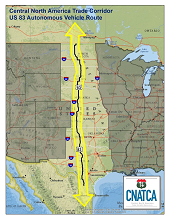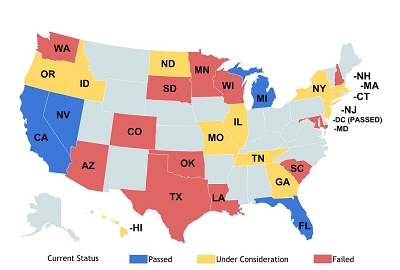States Accelerating Driverless Car Action
Burney Simpson
More states are exploring legislation on autonomous driving and more local organizations are holding conferences on driverless cars as public interest in the concept grows. The latest is North Dakota, host in May to the Central North American Trade Corridor Association (CNATCA) Summit, and where the state legislature this month passed a bill calling for a study on autonomous vehicles.
There are 15 states that now are considering legislation related to driverless technology, according to the Automated Driving: Legislative and Regulatory Action website from the Center for Internet and Society at Stanford University, the creator of the graphic of the U.S. used for this story.
The Center acknowledges the data isn‘t always up to date, and indeed its current map of the states fails to reflect that Maryland is now considering funding a task force on autonomous driving (“Maryland a Step Closer to Driverless Roads,” March 5). Still, the website provides a concise source on state legislative activities and autonomous driving.
Meanwhile, the National Conference of State Legislatures is building a website devoted to state activity on driverless transportation according to Anne Teigen, a program principal/attorney who focuses on transportation issues for the NCSL, an organization that provides research and other services to state legislators and their staff.
The site is scheduled to be launched in May and include a comprehensive list of state legislative activity, NCSL studies, stories on the topic, and several blogs, said Teigen.
AUTONOMOUS FRIENDLY CORRIDOR

The North Dakota Legislature in March passed a bill calling for a study of automated motor vehicles to be conducted later this year or in 2016. State Sen. George Sinner notes that North Dakota’s climate offers an alternative for testing driverless vehicles compared with the weather in California, Florida, Michigan, and Nevada, the states that already allow such testing.
“Our road conditions are very different. We have snow, icy roads, white outs. That’s why we think this is a good idea,” said Sinner. “These autonomous vehicles are going to have to operate in this climate too.”
North Dakota is also home to CNATCA, a not-for-profit that seeks to grow trade in the Central Plains through the six states of North Dakota, South Dakota, Nebraska, Kansas, Oklahoma and Texas.
One part of its strategy is to create what it calls an “Autonomous Friendly Corridor” about 20 miles wide with US 83 at its center as it travels nearly 1,900 miles from Canada to Mexico. CNATCA would like to see long-haul autonomous vehicles and unmanned drones carry and deliver goods up and down the corridor.
“(North Dakota is) in an energy boom right now and so is Texas. We’re seeking to develop a better infrastructure for moving goods North to South,” said Marlo Anderson, a CNATCA board member. “There’s a shortage of drivers, and our roads are under-used from midnight to early morning. Autonomous vehicles would address both issues.”
The CNATCA Summit will be held May 18-20 at Bismarck State College in Bismarck, N.D. The first day of the summit features demonstrations from companies developing such unmanned vehicles as drones and driverless cars. The demo is organized by AUVSI, the Association for Unmanned Vehicle Systems International.
The AUVSI is also a sponsor of the Automated Vehicle Symposium 2015 to be held July 21-23 in Ann Arbor, Michigan.

